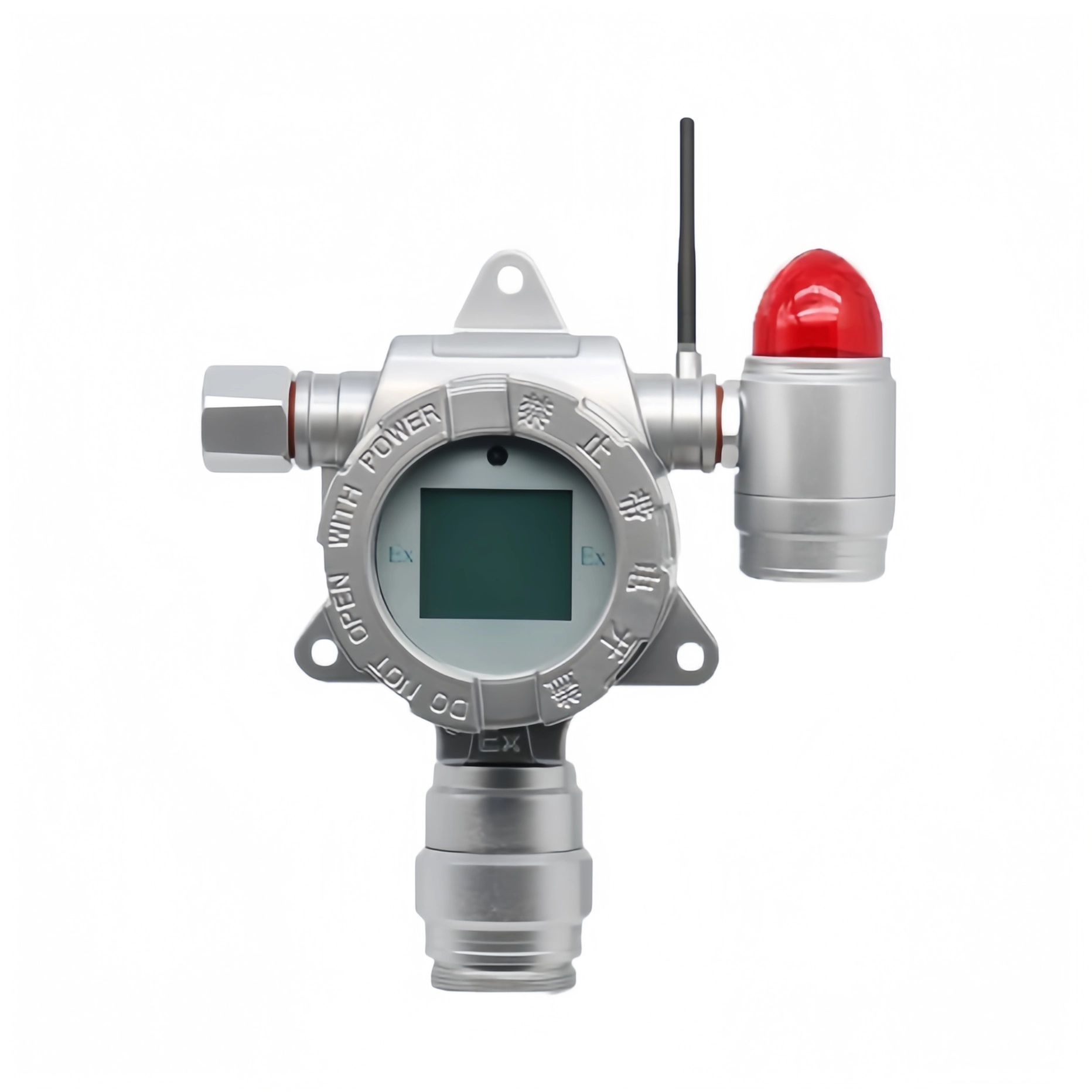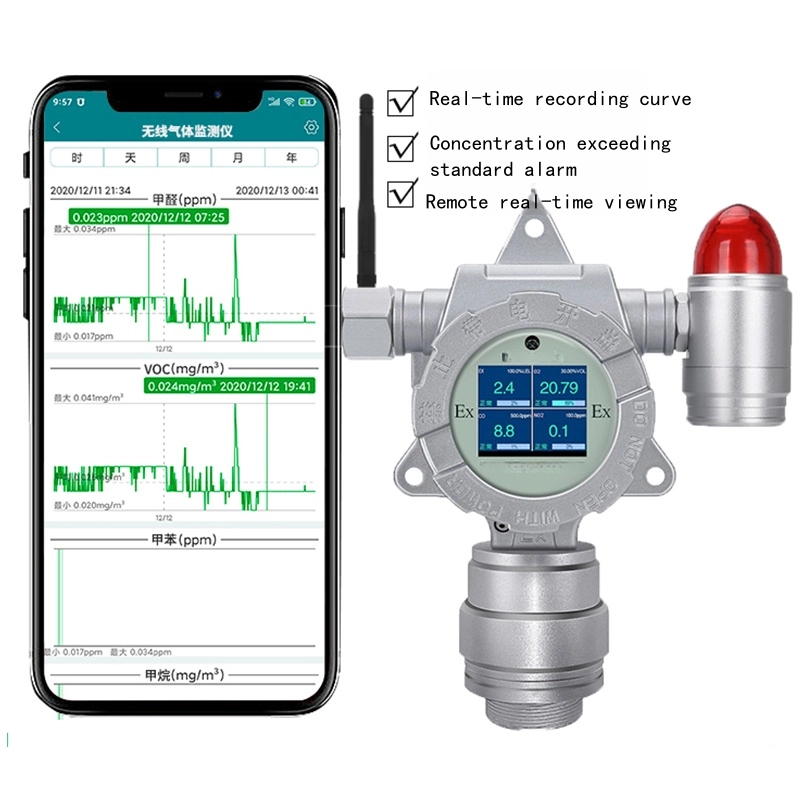1000-WX Wireless gas detector adds wireless transmission to the fixed gas detector. On-site application only needs to power the detector, no wiring is required. Using wireless signals such as GPRS, 4G, WIFI, LORA, ZigBee, etc., the on-site gas concentration signal can be transmitted to the rear monitoring room.
Gas sampling methods are optional: diffusion, pump suction, and pipeline. Wireless gas detectors are suitable for situations where the detector is far away from the control center and is used on-site or without network signals.
Features
- GPRS/4G, nRF, Zigbee, WIFI output, saving customers the trouble of wiring;
- Explosion-proof design, explosion-proof mark is ExdⅡCT6Gb;
- Large screen display, intuitively displaying gas concentration, type, unit, range, concentration column status diagram and other information;
- Using arrow menu, zero adjustment, calibration, low alarm, high alarm, reset and other operations are intuitive and clear;
- Can be equipped with remote control, no need to open the cover, simple operation;
- Alarm information is richer: LCD alarm level display, LCD red backlight is on, sound and light alarm is turned on (optional);
- The independent design of the gas chamber, combined with aerodynamics, can detect the target gas more quickly and accurately;
- Full range temperature digital automatic tracking compensation to ensure measurement accuracy;
- With data recovery function, there is no need to worry about misoperation;
Specifications
| Detection gas | Combustible and toxic gases |
| Detection principle | Electrochemical, PID photoionization, infrared, catalytic combustion |
| Detection range | 0-100PPM, 0-100%LEL, 0-100%VOL (Please consult for other ranges) |
| Resolution | Customizable |
| Working voltage | DC24V±6V |
| Shell material | Aluminum alloy |
| Detection method | Diffusion, pump suction, pipeline |
| Detection accuracy | ±3% |
| Response time | <10S |
| Key point drift | ±1%F.S/year |
| Working pressure | 85~105KPa |
| Working temperature | -20~50°C |
| Sound and light alarm | Red LED, 85db |
| Explosion-proof grade | Exd II CT6 Gb |
| Wiring thread | M20*1.5 internal thread |
| Working current | <100mA |
| Display method | LCD display |
| Installation method | Wall-mounted, pipeline, column-mounted |
| Repeat accuracy | ±3% |
| Linearity | ±2% |
| Signal output | Zigbee, WIFI, GPRS, RF |
| Product life | 2~5 years |
| Working humidity | 10~95%RH non-condensing |
| Relay | 3A@DC24V (optional) |
| Protection grade | IP65 |
| Wiring wire | RVVP3*0.75mm2 |
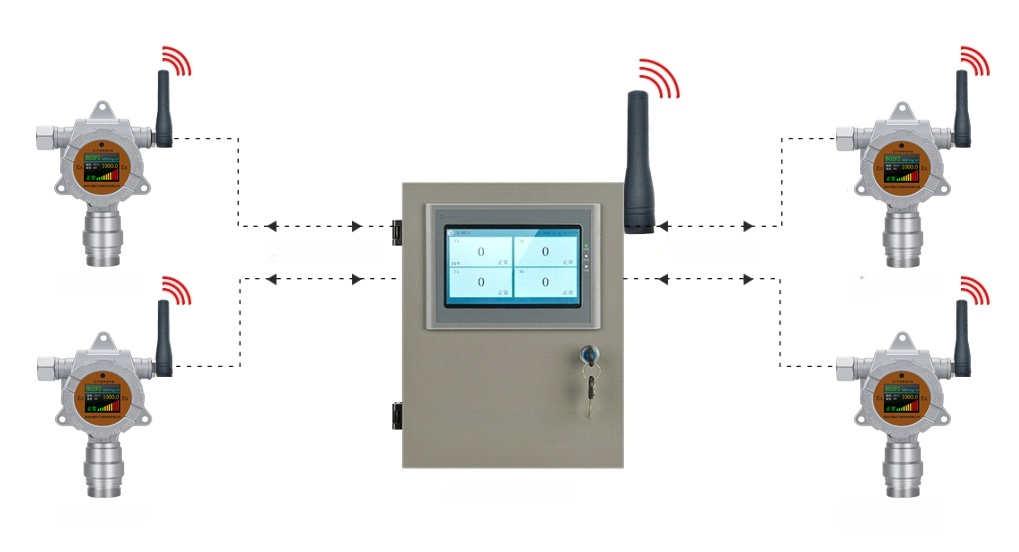
How Does the Gas Detector Achieve Wireless Remote Transmission?
1. Overview of gas detector signal transmission
There are basically two data transmission methods at present, wired data transmission and wireless data transmission.
If wired data is transmitted, the technology is simple, mature and easy to implement. However, the construction and wiring workload is large, the network cable is easily damaged by human beings, and the fault point is not easy to find after the line is damaged.
If a wireless system is used, the construction is very simple, the system is easy to maintain, and the fault is easy to find. Therefore, wireless transmission will be used in many fields and is also the mainstream direction of future development.
2. Composition of gas detection instrument system
Different project details can be configured with different gas detection systems. For example, we Sino-Inst provide harmful gas concentration monitoring for tunnel projects. The main monitored gas types are sulfur dioxide, methane, carbon monoxide, oxygen, and ammonia.
The wireless signal module configured in the instrument itself can achieve a wireless data transmission distance of 3-4 kilometers. However, with the different working conditions and curves of the tunnel, a signal repeater may need to be configured. Depending on the specific length of the tunnel, 1-2 signal repeaters are configured.
Due to the long transmission distance, a combination of wireless GPRS network transmission and spread spectrum technology is used. A monitoring terminal is set up in the environmental protection control room. A set of centralized monitoring software is provided.
The system consists of the following:
1. Real-time monitoring of front-end toxic gas detectors (mainly ammonia detectors, oxygen detectors, and hydrogen sulfide detectors).
2. The detector RS485 modbus signal output is wirelessly sent to the receiving module at the tunnel entrance through the embedded wireless RF module, and the long-distance GPRS network module is connected to the wireless receiving module to connect to the control room for wireless seamless transmission monitoring.
3. Control center: a set of monitoring computers (or the user’s existing computer is used as the monitoring host).
4. A set of data acquisition software.
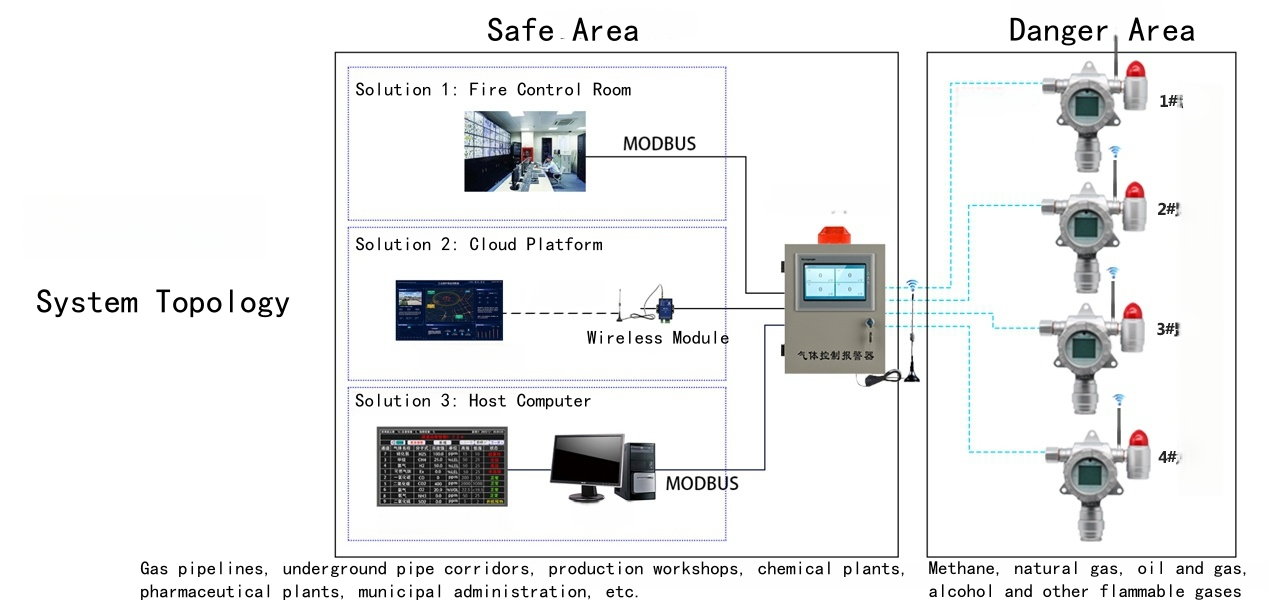
Fixed Wireless Gas Detector Detectable Gases and Measuring Ranges
| Detection gas | Range | Maximum allowable error | Minimum reading | Response time T90 |
| Combustible gas (EX) | 0-100%LEL | <±3%(F.S) | 0.1%LEL | ≤10 seconds |
| Combustible gas (EX) | 0-100%Vol | <±3%(F.S) | 0.1%Vol | ≤10 seconds |
| Methane (CH4) | 0-100%LEL | <±3%(F.S) | 0.1%LEL | ≤10 seconds |
| Methane (CH4) | 0-100%Vol | <±3%(F.S) | 0.1%Vol | ≤10 seconds |
| Oxygen (O2) | 0-30%Vol | <±3%(F.S) | 0.01%Vol | ≤10 seconds |
| Oxygen (O2) | 0-100%Vol | <±3%(F.S) | 0.01%Vol | ≤10 seconds |
| Oxygen (O2) | 0-5000ppm | <±3%(F.S) | 1ppm | ≤30 seconds |
| Nitrogen (N2) | 0-100%Vol | <±3%(F.S) | 0.01%Vol | ≤10 seconds |
| Carbon monoxide (CO) | 0-100ppm | <±3%(F.S) | 0.1ppm | ≤25 seconds |
| Carbon monoxide (CO) | 0-1000ppm | <±3%(F.S) | 0.1ppm | ≤25 seconds |
| Carbon monoxide (CO) | 0-2000ppm | <±3%(F.S) | 0.1ppm | ≤25 seconds |
| Carbon monoxide (CO) | 0-20000ppm | <±3%(F.S) | 1ppm | ≤25 seconds |
| Carbon monoxide (CO) | 0-100000ppm | <±3%(F.S) | 1ppm | ≤20 seconds |
| Carbon dioxide (CO2) | 0-500ppm | <±3%(F.S) | 1ppm | ≤20 seconds |
| Carbon dioxide (CO2) | 0-2000ppm | <±3%(F.S) | 1ppm | ≤20 seconds |
| Carbon dioxide (CO2) | 0-5000ppm | <±3%(F.S) | 1ppm | ≤30 seconds |
| Carbon dioxide (CO2) | 0-50000ppm | <±3%(F.S) | 1ppm | ≤30 seconds |
| Carbon dioxide (CO2) | 0-20%Vol | <±3%(F.S) | 0.01%Vol | ≤30 seconds |
| Carbon dioxide (CO2) | 0-100%Vol | <±3%(F.S) | 0.01%Vol | ≤30 seconds |
| Carbon dioxide (CO2) | 0-10ppm | <±3%(F.S) | 0.001ppm | ≤30 seconds |
| Formaldehyde (CH2O) | 0-10ppm | <±3%(F.S) | 0.01ppm | ≤30 seconds |
| Formaldehyde (CH2O) | 0-100ppm | <±3%(F.S) | 0.01ppm | ≤45 seconds |
| Formaldehyde (CH2O) | 0-1000ppm | <±3%(F.S) | 1ppm | ≤20 seconds |
| Ozone (O3) | 0-1ppm | <±3%(F.S) | 0.001ppm | ≤20 seconds |
| Ozone (O3) | 0-5ppm | <±3%(F.S) | 0.001ppm | ≤20 seconds |
| Ozone (O3) | 0-50ppm | <±3%(F.S) | 0.01ppm | ≤30 seconds |
| Ozone (O3) | 0-100ppm | <±3%(F.S) | 0.01ppm | ≤30 seconds |
| Ozone (O3) | 0-2000ppm | <±3%(F.S) | 0.1ppm | ≤30 seconds |
| Ozone (O3) | 0-30000ppm | <±3%(F.S) | 1ppm | ≤30 seconds |
| Ozone (O3) | 0-20mg/L | <±3%(F.S) | 0.01mg/L | ≤30 seconds |
| Ozone water (O3) | 0-20mg/L | <±3%(F.S) | 0.01mg/L | ≤30 seconds |
| Hydrogen sulfide (H2S) | 0-10ppm | <±3%(F.S) | 0.001ppm | ≤30 seconds |
| Hydrogen sulfide (H2S) | 0-50ppm | <±3%(F.S) | 0.01ppm | ≤30 seconds |
| Hydrogen sulfide (H2S) | 0-100ppm | <±3%(F.S) | 0.01ppm | ≤30 seconds |
| Hydrogen sulfide (H2S) | 0-2000ppm | <±3%(F.S) | 0.1ppm | ≤30 seconds |
| Hydrogen sulfide (H2S) | 0-10000ppm | <±3%(F.S) | 1ppm | ≤30 seconds |
| Sulfur dioxide (SO2) | 0-10ppm | <±3%(F.S) | 0.001ppm | ≤45 seconds |
| Sulfur dioxide (SO2) | 0-20ppm | <±3%(F.S) | 0.01ppm | ≤30 seconds |
| Sulfur dioxide (SO2) | 0-100ppm | <±3%(F.S) | 0.01ppm | ≤30 seconds |
| Sulfur dioxide (SO2) | 0-500ppm | <±3%(F.S) | 0.1ppm | ≤30 seconds |
| Sulfur dioxide (SO2) | 0-2000ppm | <±3%(F.S) | 0.1ppm | ≤30 seconds |
| Sulfur dioxide (SO2) | 0-10000ppm | <±3%(F.S) | 1ppm | ≤30 seconds |
| Nitrogen monoxide (NO) | 0-10ppm | <±3%(F.S) | 0.001ppm | ≤30 seconds |
| Nitrogen monoxide (NO) | 0-100ppm | <±3%(F.S) | 0.01ppm | ≤30 seconds |
| Nitrogen monoxide (NO) | 0-2000ppm | <±3%(F.S) | 0.1ppm | ≤30 seconds |
| Nitrogen dioxide (NO2) | 0-5000ppm | <±3%(F.S) | 1ppm | ≤30 seconds |
| Nitrogen dioxide (NO2) | 0-10ppm | <±3%(F.S) | 0.001ppm | ≤30 seconds |
| Nitrogen dioxide (NO2) | 0-100ppm | <±3%(F.S) | 0.01ppm | ≤30 seconds |
| Nitrogen dioxide (NO2) | 0-1000ppm | <±3%(F.S) | 0.1ppm | ≤25 seconds |
| Nitrogen dioxide (NO2) | 0-5000ppm | <±3%(F.S) | 1ppm | ≤25 seconds |
| Nitrogen dioxide (NO2) | 0-10ppm | <±3%(F.S) | 0.001ppm | ≤30 seconds |
| Nitrogen oxides (NOX) | 0-100ppm | <±3%(F.S) | 0.01ppm | ≤30 seconds |
| Nitrogen oxides (NOX) | 0-2000ppm | <±3%(F.S) | 0.1ppm | ≤30 seconds |
| Nitrogen oxides (NOX) | 0-5000ppm | <±3%(F.S) | 1ppm | ≤30 seconds |
| Chlorine (CL2) | 0-10ppm | <±3%(F.S) | 0.001ppm | ≤30 seconds |
| Chlorine (CL2) | 0-20ppm | <±3%(F.S) | 0.01ppm | ≤30 seconds |
| Chlorine (CL2) | 0-200ppm | <±3%(F.S) | 0.1ppm | ≤30 seconds |
| Chlorine (CL2) | 0-2000ppm | <±3%(F.S) | 0.1ppm | ≤30 seconds |
| Ammonia (NH3) | 0-50ppm | <±3%(F.S) | 0.01ppm | ≤30 seconds |
| Ammonia (NH3) | 0-100ppm | <±3%(F.S) | 0.01ppm | ≤30 seconds |
| Ammonia (NH3) | 0-1000ppm | <±3%(F.S) | 0.1ppm | ≤30 seconds |
| Ammonia (NH3) | 0-5000ppm | <±3%(F.S) | 1ppm | ≤30 seconds |
| Ammonia (NH3) | 0-100%LEL | <±3%(F.S) | 0.1%LEL | ≤30 seconds |
| Hydrogen (H2) | 0-100%LEL | <±3%(F.S) | 0.1%LEL | ≤30 seconds |
| Hydrogen (H2) | 0-1000ppm | <±3%(F.S) | 0.1ppm | ≤30 seconds |
| Hydrogen (H2) | 0-20000ppm | <±3%(F.S) | 1ppm | ≤30 seconds |
| Hydrogen (H2) | 0-40000ppm | <±3%(F.S) | 1ppm | ≤30 seconds |
| Hydrogen (H2) | 0-100%Vol | <±3%(F.S) | 0.01%Vol | ≤30 seconds |
| Helium (He) | 0-100%Vol | <±3%(F.S) | 0.01%Vol | ≤10 seconds |
| Argon (Ar) | 0-100%Vol | <±3%(F.S) | 0.01%Vol | ≤10 seconds |
| Xenon (Xe) | 0-100%Vol | <±3%(F.S) | 0.01%Vol | ≤30 seconds |
| Hydrogen cyanide (HCN) | 0-30ppm | <±3%(F.S) | 0.01ppm | ≤30 seconds |
| Hydrogen cyanide (HCN) | 0-100ppm | <±3%(F.S) | 0.01ppm | ≤30 seconds |
| Hydrogen chloride (HCL) | 0-20ppm | <±3%(F.S) | 0.01ppm | ≤30 seconds |
| Hydrogen chloride (HCL) | 0-200ppm | <±3%(F.S) | 0.1ppm | ≤20 seconds |
| Phosphine (PH3) | 0-5ppm | <±3%(F.S) | 0.001ppm | ≤20 seconds |
| Phosphine (PH3) | 0-25ppm | <±3%(F.S) | 0.01ppm | ≤20 seconds |
| Phosphine (PH3) | 0-2000ppm | <±3%(F.S) | 1ppm | ≤30 seconds |
| Chlorine dioxide (CLO2) | 0-1ppm | <±3%(F.S) | 0.001ppm | ≤30 seconds |
| Chlorine dioxide (CLO2) | 0-10ppm | <±3%(F.S) | 0.01ppm | ≤30 seconds |
| Chlorine dioxide (CLO2) | 0-200ppm | <±3%(F.S) | 0.01ppm | ≤30 seconds |
| Ethylene oxide (ETO) | 0-100ppm | <±3%(F.S) | 0.01ppm | ≤30 seconds |
| Ethylene oxide (ETO) | 0-1000ppm | <±3%(F.S) | 0.1ppm | ≤30 seconds |
| Ethylene oxide (ETO) | 0-100%LEL | <±3%(F.S) | 1%LEL | ≤30 seconds |
| Phosgene (COCL2) | 0-1ppm | <±3%(F.S) | 0.001ppm | ≤30 seconds |
| Phosgene (COCL2) | 0-50ppm | <±3%(F.S) | 0.01ppm | ≤30 seconds |
| Silane (SiH4) | 0-1ppm | <±3%(F.S) | 0.001ppm | ≤30 seconds |
| Silane (SiH4) | 0-50ppm | <±3%(F.S) | 0.01ppm | ≤30 seconds |
| Fluorine (F2) | 0-1ppm | <±3%(F.S) | 0.001ppm | ≤30 seconds |
| Fluorine (F2) | 0-10ppm | <±3%(F.S) | 0.01ppm | ≤30 seconds |
| Fluorine (F2) | 0-50ppm | <±3%(F.S) | 0.01ppm | ≤30 seconds |
| Hydrogen fluoride (HF) | 0-10ppm | <±3%(F.S) | 0.01ppm | ≤20 seconds |
| Hydrogen fluoride (HF) | 0-50ppm | <±3%(F.S) | 0.01ppm | ≤20 seconds |
| Hydrogen bromide (HBr) | 0-50ppm | <±3%(F.S) | 0.01ppm | ≤30 seconds |
| Diborane (B2H6) | 0-10ppm | <±3%(F.S) | 0.001ppm | ≤30 seconds |
| Arsine (AsH3) | 0-1ppm | <±3%(F.S) | 0.001ppm | ≤30 seconds |
| Arsine (AsH3) | 0-10ppm | <±3%(F.S) | 0.01ppm | ≤30 seconds |
| Arsine (AsH3) | 0-50ppm | <±3%(F.S) | 0.01ppm | ≤30 seconds |
| Germane (GeH4) | 0-2ppm | <±3%(F.S) | 0.001ppm | ≤30 seconds |
| Germane (GeH4) | 0-20ppm | <±3%(F.S) | 0.01ppm | ≤30 seconds |
| Hydrazine (N2H4) | 0-1ppm | <±3%(F.S) | 0.001ppm | ≤30 seconds |
| Hydrazine (N2H4) | 0-300ppm | <±3%(F.S) | 0.1ppm | ≤30 seconds |
| Tetrahydrothiophene (THT) | 0-100mg/m3 | <±3%(F.S) | 0.01mg/m3 | ≤30 seconds |
| Bromine (Br2) | 0-10ppm | <±3%(F.S) | 0.001ppm | ≤30 seconds |
| Bromine (Br2) | 0-100ppm | <±3%(F.S) | 0.01ppm | ≤30 seconds |
| Bromine (Br2) | 0-2000ppm | <±3%(F.S) | 1ppm | ≤30 seconds |
| Acetylene (C2H2) | 0-100%LEL | <±3%(F.S) | 0.1%LEL | ≤30 seconds |
| Acetylene (C2H2) | 0-100ppm | <±3%(F.S) | 0.01ppm | ≤30 seconds |
| Acetylene (C2H2) | 0-1000ppm | <±3%(F.S) | 0.1ppm | ≤30 seconds |
| Ethylene (C2H4) | 0-100%LEL | <±3%(F.S) | 0.1%LEL | ≤30 seconds |
| Ethylene (C2H4) | 0-100ppm | <±3%(F.S) | 0.01ppm | ≤30 seconds |
| Ethylene (C2H4) | 0-2000ppm | <±3%(F.S) | 0.1ppm | ≤30 seconds |
| Acetaldehyde (C2H4O) | 0-10ppm | <±3%(F.S) | 0.01ppm | ≤30 seconds |
| Ethanol (C2H6O) | 0-100ppm | <±3%(F.S) | 0.01ppm | ≤30 seconds |
| Ethanol (C2H6O) | 0-2000ppm | <±3%(F.S) | 1ppm | ≤60 seconds |
| Methanol (CH6O) | 0-100ppm | <±3%(F.S) | 0.01ppm | ≤30 seconds |
| Methanol (CH6O) | 0-2000ppm | <±3%(F.S) | 1ppm | ≤30 seconds |
| Carbon disulfide (CS2) | 0-50ppm | <±3%(F.S) | 0.01ppm | ≤30 seconds |
| Carbon disulfide (CS2) | 0-5000ppm | <±3%(F.S) | 0.01ppm | ≤30 seconds |
| Acrylonitrile (C3H3N) | 0-50ppm | <±3%(F.S) | 0.01ppm | ≤30 seconds |
| Acrylonitrile (C3H3N) | 0-2000ppm | <±3%(F.S) | 1ppm | ≤30 seconds |
| Methylamine (CH5N) | 0-50ppm | <±3%(F.S) | 0.01ppm | ≤30 seconds |
| I2 | 0-50ppm | <±3%(F.S) | 0.01ppm | ≤30 seconds |
| Styrene (C8H8) | 0-200ppm | <±3%(F.S) | 0.1ppm | ≤30 seconds |
| Styrene (C8H8) | 0-5000ppm | <±3%(F.S) | 1ppm | ≤30 seconds |
| Vinyl chloride (C2H3CL) | 0-100ppm | <±3%(F.S) | 0.01ppm | ≤30 seconds |
| Trichloroethylene (C2HCL3) | 0-100ppm | <±3%(F.S) | 0.01ppm | ≤30 seconds |
| Tetrachloroethylene (C2CL4) | 0-100ppm | <±3%(F.S) | 0.01ppm | ≤30 seconds |
| Laughing gas (N2O) | 0-100ppm | <±3%(F.S) | 0.01ppm | ≤30 seconds |
| Nitrogen trifluoride (NF3) | 0-100ppm | <±3%(F.S) | 0.01ppm | ≤30 seconds |
| Hydrogen peroxide (H2O2) | 0-100ppm | <±3%(F.S) | 0.01ppm | ≤30 seconds |
| Sulfuryl fluoride (SO2F2) | 0-100ppm | <±3%(F.S) | 0.01ppm | ≤30 seconds |
| Sulfuryl fluoride (SO2F2) | 0-30000ppm | <±3%(F.S) | 1ppm | ≤30 seconds |
| Sulfuryl fluoride (SO2F2) | 0-200g/m3 | <±3%(F.S) | 0.1g/m3 | ≤30 seconds |
| Sulfuryl fluoride (SO2F2) | 0-100ppm | <±3%(F.S) | 0.01ppm | ≤30 seconds |
| Sulfuryl fluoride (SO2F2) | 0-5000ppm | <±3%(F.S) | 1ppm | ≤30 seconds |
| Sulfuryl fluoride (SO2F2) | 0-10000ppm | <±3%(F.S) | 1ppm | ≤30 seconds |
| C6H6 | 0-10ppm | <±3%(F.S) | 0.01ppm | ≤30 seconds |
| C6H6 | 0-100ppm | <±3%(F.S) | 0.01ppm | ≤30 seconds |
| C6H6 | 0-2000ppm | <±3%(F.S) | 1ppm | ≤30 seconds |
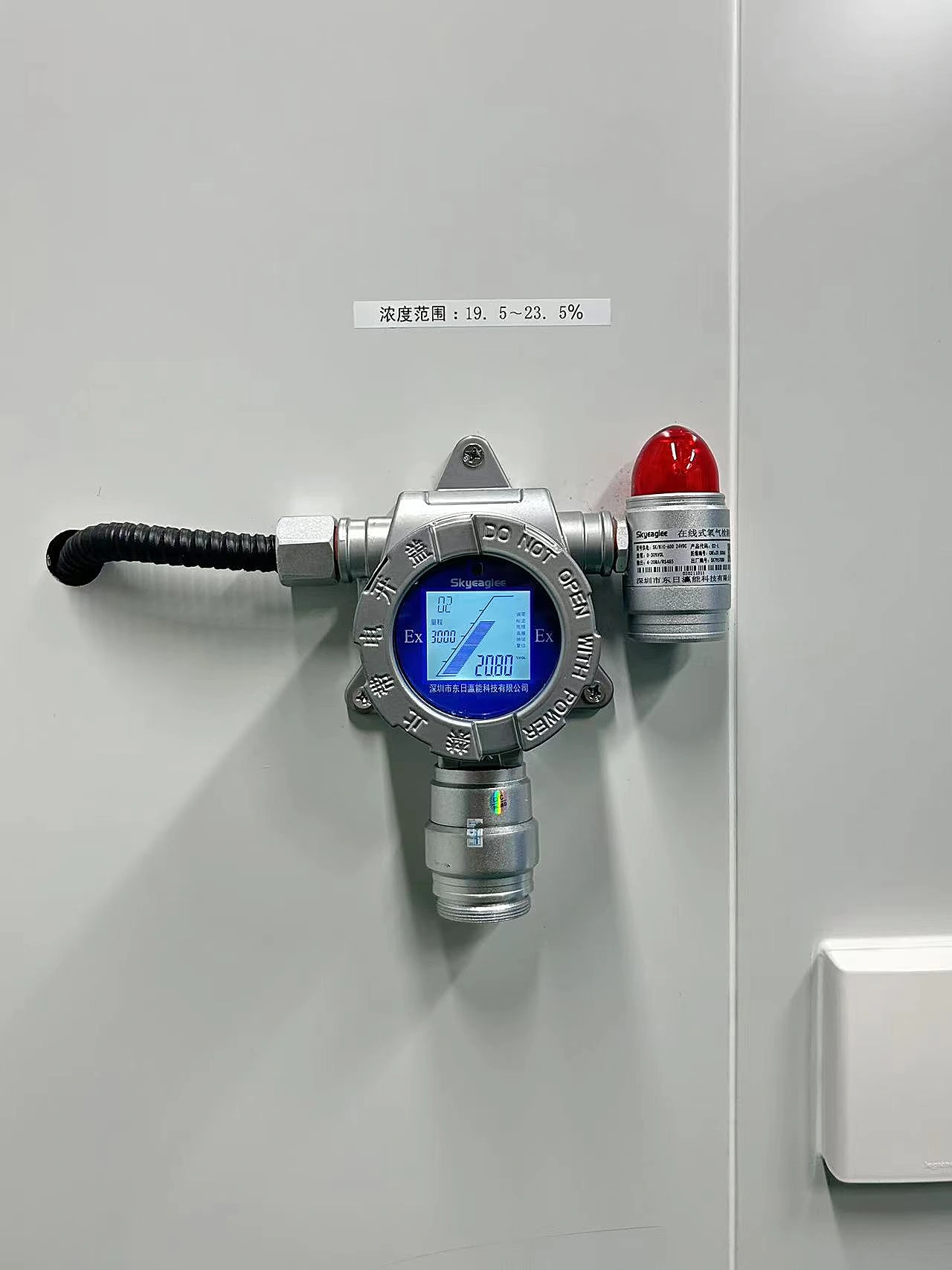
Wireless gas detectors are widely used in petroleum and petrochemical, chemical plants, smelters, steel mills, pharmaceutical production workshops, tobacco companies, environmental monitoring, industrial gas process control, gas stations, underground gas pipeline maintenance, indoor air quality detection, safety protection in hazardous areas, aerospace, military equipment monitoring, etc.
1000-WX Wireless gas detector realizes the demand for wireless gas detection, eliminating the trouble of complex wiring for customers. After installation and debugging, you can directly read the detection value in the IoT platform, view the gas detection status, generate historical curves, and analyze the gas detection value.
If you need to perform gas concentration, gas leakage and other detections, please feel free to contact our sales engineer!


